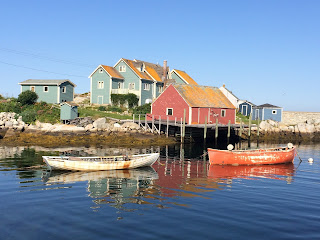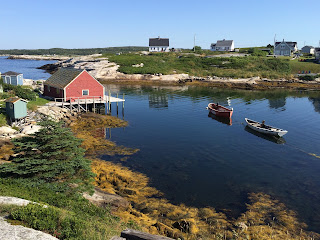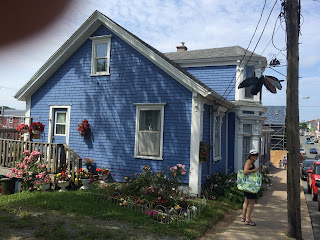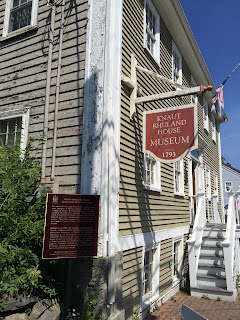Saturday,
August 5th, 2017, we woke in Lunenburg Harbour, again shrouded in
thick fog. The weather forecast indicated that it would lift, so around 10 a.m.
we raised the anchor and motored into Lunenburg Bay toward the “Ovens”, a
couple of huge sea caves on the south shore, conveniently on our way.
 |
| Foggy morning in Lunenburg as we prepare to leave port. |
The wind picked up and we sailed around the
corner and continued southwesterly to the LaHave River, where we anchored off the Kraut Point fishing wharf and a nearby shore offering protection from the wind and waves.
 |
| Fishing boats at the wharf at Kraut Point |
The next
morning we continued, but the winds had created quite a swell, and the wind
direction required us to be close hauled, something the autopilot doesn’t deal
with very well, so we hand-steered almost the whole day. The wind averaged 15-20 knots (30-40km/hr)
and the waves were building on an ever-increasing swell, then breaking, when
dense fog rolled in! Back home fog was usually associated with calm winds, but
here it comes in anything! Never a dull
moment! With the radar on, straining our eyes and ears, we navigated into Port
Medway, and just as the trickiest part was done, the fog lifted. We anchored an relatively calm waters close
to the town of Port Medway, but stayed on the boat.
Monday morning
the forecast was for westerlies in the morning, a suitable wind direction to
move down the coast, so we hurried up and made coffee and breakfast while we
were underway. Close-hauled again, the wind increased as the day went on, reaching
27 knots, and the waves increased in size in an angle to yesterday’s
swell. Tired of the pounding we were
taking, we cut into Port Motoun (pronounced “Matoon”), as the Down East Circle
Route Cruising Guide stated a beach here, Carter Beach, is likely Nova Scotia’s
most idyllic beach. We had to check it
out! We were very surprised, arriving
near low tide, that the beach was amazing, long and wide. White sand (see the
pictures!) for 3 coves, with sand dunes, and no development. In the Caribbean,
it would have been lined with resort hotels.
After we were comfortable that the anchor was holding, we dinghied into
shore for a long walk on the beach. There were granite boulders on the fringes
similar to the Baths in the Virgin Islands or the Maldives. Beautiful! Apparently, this beautiful beach wasn’t a secret,
because there were a lot of people on it.
 |
| Carter Beach on Port Motoun |



 |
| Fresh mackerel! Yum! |
When we
returned to the boat, 3 locals that had been out mackerel fishing stopped by to
offer us part of their catch! We gratefully accepted 2, and we quickly had them
cleaned and on the grill!
Tuesday’s
forecast called for high winds overnight so we had to look for a well protected
spot. We found it at Lockeport, where their harbour is fully enclosed and safe
in all winds. We stayed a rare night at a dock at the White Gull Restaurant and
Marina, but found, contrary to the cruising guide, it had no diesel, no water
and no power. We later noticed that a neighbouring Wharf, part of the marina,
had power outlets, and moved over there, tying spring lines to deal with the 5
foot tidal range.
 |
| Historic residences in Lockeport |
Wednesday,
August 5th, we made our way to Shelburne, Nova Scotia. We anchored
south of the Shelburne Harbour Yacht Club’s mooring field, in front of historic
Dock Street. Tied to moorings, and
crowding the docks were a number of schooners, which we later found out
gathered in Shelburne this year for their annual schooner race week. After anchoring, we went to the yacht club
and for a walk.
 |
| Schooners taking part in the daily races! |
The buildings
on the waterfront were very well maintained, courtesy of Hollywood who provided
a facelift for a number of them with Shelburne was used in the 1994 movie,” The
Scarlet Letter”.
 |
| A few examples of the old, but often well preserved buildings on Dock Street |
 |
| The boat shed |
Thursday was
grocery day in the morning, and laundry day in the afternoon. I spoke to
sailors at the club to learn of issues and advice in crossing the Gulf of
Maine, where the Bay of Fundy tidal range, the highest in the world, also
creates strong currents that must be considered when navigating these waters.
Friday, we
investigated our failing alternator, which didn’t seem to be charging the batteries
when the engine was running. A
replacement was eventually found in Bridgwater at Rob’s Starter Repair, and he
would courier it to us right away. Thanks, Rob!
That evening we learned that the Lobster Shack was catering for the yacht
club’s Friday night dinner, and for $14 each we received a heaping lobster roll
with a large serving of pasta salad. Delicious!
 |
| We have taken a liking to lobster rolls here in Nova Scotia! |
 |
| The schooner Columbia in one of the races |
Saturday, our 3rd
month after leaving the North Channel Yacht Club in Spragge, Ontario, we
visited the Shelburne farmer’s market, and drove Vata to the fuel dock for
diesel and water. It rained here all afternoon, and most of Sunday, so we took
care of a few chores on the boat, and we came over to the yacht club to charge
our computer and update the blog.
 |
| Part of the historic waterfront on Dock Street as seen from our place in the anchorage. |
 |
| The Mist of Avalon from Liverpool NS in Shelburne |
































































